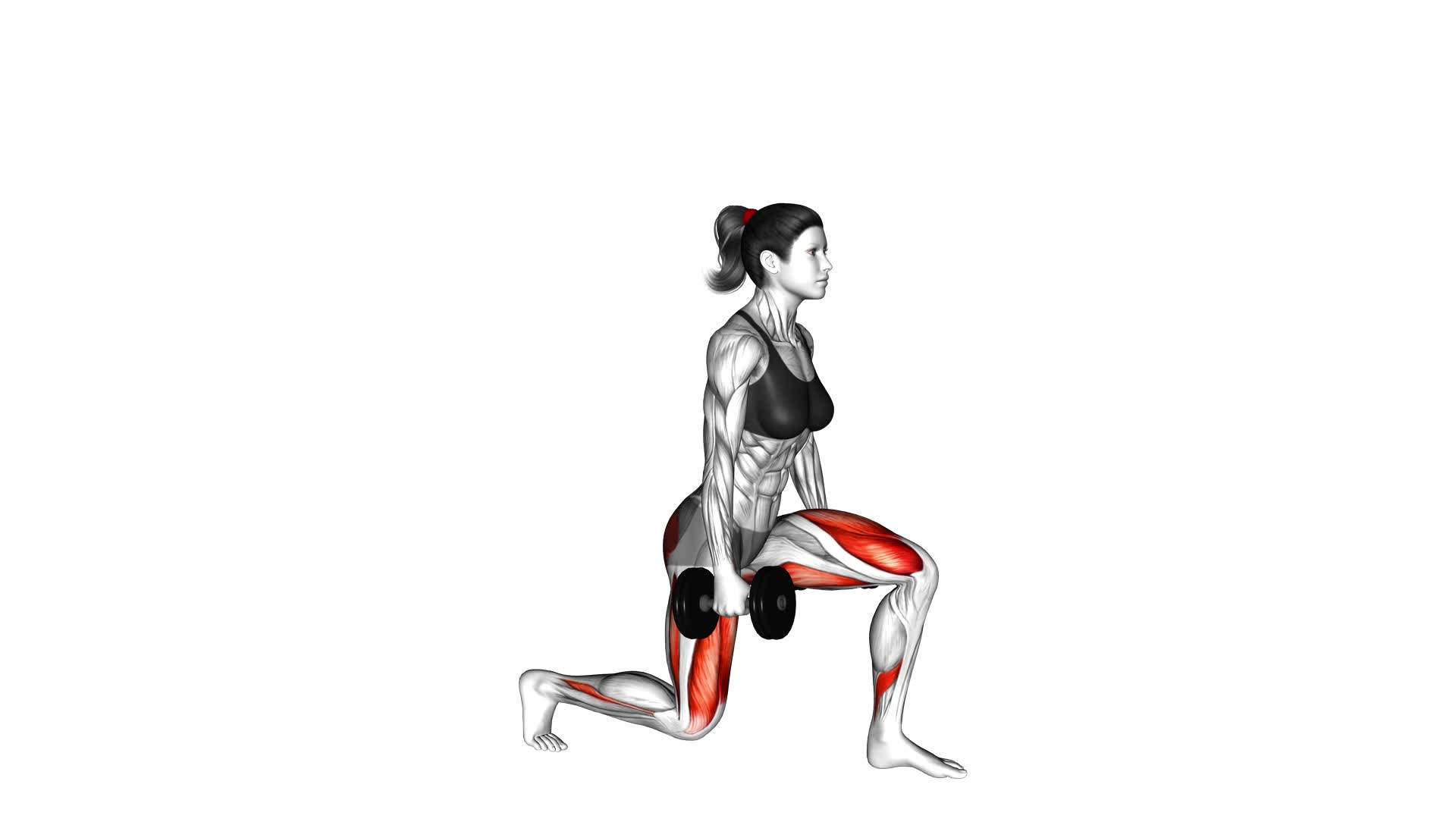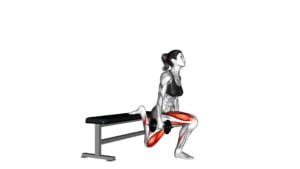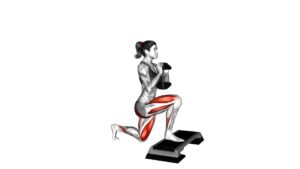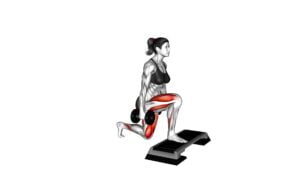Dumbbell Split Squat (female) – Video Exercise Guide & Tips

Looking to tone your legs and build strength? The dumbbell split squat is a powerful exercise that targets your quads, glutes, and hamstrings.
Watch This Exercise Video
In this video exercise guide, we'll show you the proper form and technique to get the most out of this exercise.
Whether you're a beginner or advanced, we've got tips and modifications to suit your fitness level.
Get ready to feel the burn and achieve your fitness goals with the dumbbell split squat.
Key Takeaways
- Dumbbell split squats target quads, glutes, and hamstrings
- Proper form and technique include standing with feet hip-width apart and lowering the body into a squat with knees at a 90-degree angle
- Beginners should start with lighter dumbbell weights and gradually increase weight as muscles adapt
- Consistency and progress are essential for seeing results in strength and muscle growth
Benefits of Dumbbell Split Squat
You can experience improved balance and increased leg strength by incorporating dumbbell split squats into your workout routine. This exercise targets multiple muscle groups, including the quadriceps, hamstrings, glutes, and calves, making it an efficient way to build lower body strength.
One of the key benefits of the dumbbell split squat is its ability to enhance stability and balance. By standing on one leg and lowering your body into a lunge position, you engage your core and stabilizing muscles, which can improve your overall balance.
Additionally, the dumbbell split squat helps to build strength in the legs. The combination of the lunge movement and the added resistance from the dumbbells challenges your muscles, promoting muscle growth and strength development.
To maximize the benefits of this exercise, it's important to maintain proper form and technique. Start by standing upright with one foot placed in front of the other, toes pointing forward. Lower your body into a lunge position, keeping your front knee in line with your ankle and your back knee hovering just above the ground. Keep your torso upright and engage your core throughout the movement.
As you push through your front heel to return to the starting position, focus on maintaining control and stability. By following these guidelines, you can reap the benefits of the dumbbell split squat and achieve improved balance and leg strength.
Proper Form and Technique
To ensure proper form and technique while performing the dumbbell split squat, focus on maintaining control and stability throughout the movement. This exercise is highly effective for targeting the muscles in your legs, glutes, and core, so maximizing results requires proper execution.
Start by standing with your feet hip-width apart and hold a dumbbell in each hand. Take a step forward with one foot, positioning it far enough that when you lower your body into a squat, your knee is directly above your ankle. Keep your torso upright and engage your core as you lower your body, bending both knees to a 90-degree angle.
Make sure your front knee stays in line with your toes and avoid letting it collapse inward. Push through your front heel to return to the starting position. Common mistakes to avoid include leaning too far forward, not going low enough, and allowing your front knee to extend past your toes.
By maintaining control, stability, and proper form, you can maximize the benefits of the dumbbell split squat and prevent injury.
Transitioning into the next section, let's now discuss the recommended dumbbell weight for this exercise.
Recommended Dumbbell Weight
When determining the recommended dumbbell weight for your dumbbell split squats, it's important to consider several factors.
As a beginner, start with a lighter weight to focus on proper form and technique.
As you progress, gradually increase the weight to challenge your muscles and continue making progress.
Finding Appropriate Weight
Select a dumbbell weight that challenges you but allows you to maintain proper form throughout the dumbbell split squat exercise. This is crucial for progression and avoiding injuries. As you perform the exercise, pay attention to your body's response and adjust the weight accordingly.
If the weight feels too light and you can easily complete all the repetitions, it may be time to increase the weight. On the other hand, if you find it difficult to maintain proper form or experience discomfort or pain, the weight may be too heavy. It's important to find a balance that challenges your muscles without compromising your technique.
Now, let's move on to discussing the appropriate weight for beginners.
Weight for Beginners
Start with a dumbbell weight that challenges you but allows you to maintain proper form during the dumbbell split squat exercise. It's important to find a weight that pushes you out of your comfort zone, but not so heavy that you sacrifice your technique.
As a beginner, it can be difficult to gauge the appropriate weight, but a good starting point is to choose a dumbbell that you can comfortably perform 10-12 repetitions with. This weight should provide enough resistance to stimulate muscle growth and progress over time.
Finding the motivation to stick with your fitness routine can be challenging, but setting specific goals can help you stay focused and committed. Whether it's aiming to increase the weight you lift or reaching a certain number of repetitions, having clear goals will keep you motivated and track your progress.
Once you have mastered the initial weight, you can gradually increase the dumbbell weight to continue challenging your muscles and progressing in your fitness journey.
Progression of Dumbbells
Once you have mastered the initial weight, gradually increase the dumbbell weight to continue challenging your muscles and progressing in your fitness journey. Dumbbell progression is crucial for building strength and muscle endurance.
As you become comfortable with the exercise and your muscles adapt, it's important to increase the weight to continue seeing results. Start by adding small increments of weight, such as 2-5 pounds, and gradually work your way up. This will ensure that your muscles are constantly challenged and stimulated.
Additionally, as you progress, you can also incorporate advanced variations of the dumbbell split squat to further intensify the exercise and target different muscle groups.
Now, let's explore some common mistakes to avoid to maximize the effectiveness of your dumbbell split squat.
Common Mistakes to Avoid
To avoid common mistakes while performing the dumbbell split squat, ensure proper form and technique. Here are some common pitfalls to watch out for:
- Improper foot placement: One of the most common mistakes is placing your feet too close together or too far apart. To maintain balance and stability, make sure your front foot is far enough in front and your back foot is positioned properly.
- Incomplete range of motion: Some people tend to cheat by not going all the way down or not fully extending their front leg. This reduces the effectiveness of the exercise. Remember to lower your body until your front thigh is parallel to the ground and fully extend your front leg on the way up.
- Leaning forward: Leaning forward can put unnecessary strain on your lower back and diminish the benefits of the exercise. Keep your torso upright and engage your core muscles to maintain proper alignment throughout the movement.
Modifications for Beginners
For beginners, it's recommended to use lighter dumbbells during the split squat exercise. This modification allows you to focus on mastering the technique and building strength without overwhelming your muscles. As a beginner, it's important to start with exercises that are beginner-friendly to prevent injury and ensure steady progress.
In addition to using lighter dumbbells, there are other modifications you can make to make the split squat more beginner-friendly.
First, you can perform the split squat without any weights at all. This bodyweight variation allows you to focus on proper form and stability before adding any additional resistance. As you become more comfortable with the movement, you can gradually increase the intensity by incorporating dumbbells.
Another modification is to reduce the range of motion. Instead of lowering your back knee all the way to the ground, you can start by only going halfway down. This reduces the stress on your joints and makes the exercise more manageable for beginners.
Lastly, you can use a bench or a step to elevate your front foot. This modification shifts more of the workload onto your front leg, making it easier for beginners to balance and stabilize.
Tips for Maximizing Results
To maximize your results with the dumbbell split squat, it's essential to focus on proper form. This means maintaining a straight back, keeping your knees aligned with your toes, and engaging your core throughout the exercise.
Additionally, consistency is key to seeing progress. Make sure to incorporate the dumbbell split squat into your regular workout routine and challenge yourself by gradually increasing the weight or number of reps.
Lastly, listen to your body and adjust the intensity or range of motion if needed to avoid injury and ensure optimal results.
Proper Form Essential
With proper form, you can maximize your results by performing the Dumbbell Split Squat. Here are some tips to ensure you have the correct form and technique:
- Maintain a neutral spine throughout the exercise to avoid straining your back.
- Keep your front knee aligned with your ankle, making sure it doesn't go past your toes.
- Engage your core muscles to stabilize your body and maintain balance.
- Start with lighter weights or no weights at all if you're a beginner to focus on mastering the movement.
- Take it slow and focus on controlled movements to prevent injury and ensure proper muscle activation.
- Avoid leaning forward or backward during the exercise, as this can put unnecessary strain on your joints.
- Use a mirror or ask a trainer for feedback to ensure your form is correct.
Consistency Yields Progress
By maintaining consistency in your Dumbbell Split Squat workouts, you can maximize your results and progress towards your fitness goals.
Maximizing consistency means sticking to a regular workout schedule and not skipping sessions. This allows your body to adapt and improve over time.
Tracking your progress is essential to see how far you've come and to set new goals. Keep a record of your weights, repetitions, and any modifications you make to the exercise. This will help you identify areas for improvement and make adjustments to your workouts.
Consistency and progress go hand in hand, so stay committed to your Dumbbell Split Squat routine and watch as your strength and fitness levels increase.
Listen to Your Body
As you progress through your Dumbbell Split Squat routine, it's important to listen to your body and make adjustments accordingly. By paying attention to your body's signals and cues, you can maximize your results and avoid potential injuries. Here are some tips to help you improve your body awareness during your workouts:
- Focus on proper form: Pay attention to your body alignment and make sure you're executing each movement correctly. This will help you target the right muscles and prevent unnecessary strain.
- Take breaks when needed: If you feel fatigued or experience any discomfort, it's important to take breaks and give your body time to recover. Pushing through pain can lead to injuries and hinder your progress.
- Modify exercises if necessary: If a particular exercise feels too challenging or causes pain, feel free to modify it to suit your body's needs. You can use lighter weights, adjust your range of motion, or try alternative variations.
Frequently Asked Questions
How Many Sets and Reps Should I Do for the Dumbbell Split Squat Exercise?
To determine the sets and reps for the dumbbell split squat exercise, it's important to consider your fitness goals and current fitness level. Generally, it's recommended to start with 2-3 sets of 8-12 reps per leg.
However, you can adjust the volume and intensity depending on your needs.
Additionally, there are variations of the dumbbell split squat, such as adding weights or using different foot positions, which can also impact the sets and reps you should do.
Can I Perform the Dumbbell Split Squat Exercise With a Barbell Instead of Dumbbells?
Yes, you can perform the dumbbell split squat exercise with a barbell instead of dumbbells. The barbell modification can provide additional stability and support, allowing you to increase the weight and intensity of the exercise.
However, using dumbbells has its own benefits, such as improved balance and targeting of individual leg strength.
Ultimately, the choice between barbells and dumbbells depends on your personal preference and fitness goals.
Is It Normal to Feel Some Discomfort or Soreness in My Knees While Performing the Dumbbell Split Squat?
Feeling some discomfort or soreness in your knees while performing dumbbell split squats isn't uncommon. It's important to ensure you're using proper form to minimize strain on your knees.
Focus on keeping your front knee aligned with your ankle and avoid letting it extend past your toes.
Additionally, you can modify the exercise by reducing the weight or using a step or elevated surface for support.
Listen to your body and adjust as needed to prevent further discomfort.
Can I Incorporate the Dumbbell Split Squat Exercise Into My Cardio or HIIT Routine?
You can definitely incorporate the dumbbell split squat into your cardio or HIIT routine. It's a great exercise for lower body strength and stability. By adding dumbbells to the split squat, you increase the intensity and challenge your muscles even more.
This exercise targets your glutes, quads, and hamstrings, helping to improve your overall lower body strength. It's an effective way to add variety to your cardio or HIIT workouts while still reaping the benefits of the dumbbell split squat.
Are There Any Specific Breathing Techniques I Should Follow During the Dumbbell Split Squat Exercise?
When performing the dumbbell split squat, it's important to focus on your breathing technique. Take a deep breath in as you lower your body down, and exhale as you push back up. This will help you maintain proper form and stability throughout the exercise.
Conclusion
In conclusion, the dumbbell split squat is a highly effective exercise for targeting the lower body muscles, especially the quads, glutes, and hamstrings.
By maintaining proper form and technique, using the recommended dumbbell weight, and avoiding common mistakes, you can maximize your results and achieve a stronger and more toned lower body.
Beginners can also benefit from modifications to gradually build strength and improve balance.
Incorporate these tips into your workout routine for optimal results.

Author
Years ago, the spark of my life’s passion ignited in my mind the moment I stepped into the local gym for the first time. The inaugural bead of perspiration, the initial endeavor, the very first surge of endorphins, and a sense of pride that washed over me post-workout marked the beginning of my deep-seated interest in strength sports, fitness, and sports nutrition. This very curiosity blossomed rapidly into a profound fascination, propelling me to earn a Master’s degree in Physical Education from the Academy of Physical Education in Krakow, followed by a Sports Manager diploma from the Jagiellonian University. My journey of growth led me to gain more specialized qualifications, such as being a certified personal trainer with a focus on sports dietetics, a lifeguard, and an instructor for wellness and corrective gymnastics. Theoretical knowledge paired seamlessly with practical experience, reinforcing my belief that the transformation of individuals under my guidance was also a reflection of my personal growth. This belief holds true even today. Each day, I strive to push the boundaries and explore new realms. These realms gently elevate me to greater heights. The unique combination of passion for my field and the continuous quest for growth fuels my drive to break new ground.



